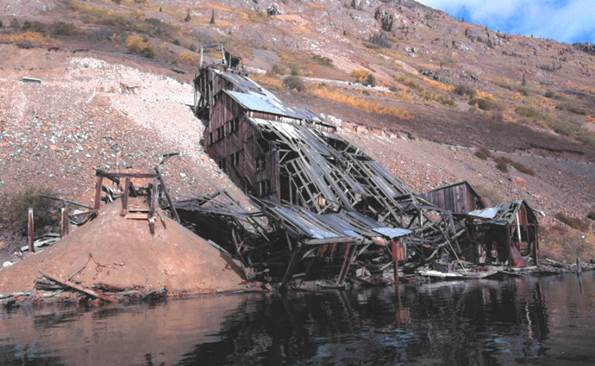Researcher: Michael Gates
Contact Information: msgates@northwestel.net

Research Inquiry Background
I am currently working on a contract for the Historic Sites branch of the Government of Yukon. My assignment is to gather information regarding the technology of an old silver mine ore processing mill called “The Venus Mill.” It is located on the west shore of Windy Arm (a branch of Tagish Lake) a few miles south of Carcross, Yukon.
Specifically, I am gathering information about the equipment still extant in the derelict structure, or that were used in the building during its period of active use.
Unfortunately, the mill, which is on an unstable slope, is currently buried in snow with temperatures dropping to minus thirty degrees. Some of the pieces of equipment hare partially buried by the slumping material on the slope.
Several mining companies were involved in the operation of the mine during this period:
The mill was built and first operated by Conrad Consolidated Mines (1907-1912), in 1912 the mine and mill were leased to Yukon District Gold (but it appears they did not do any work). In 1916 the lease was bought by the Harper Syndicate made up of Lakinaw and Tagish Mines. The syndicate was headquartered in Seattle. In 1918 the Montana-Yukon Mining Company took over operation (They were headquartered in Butte, Montana, USA).
The mill operated during two periods, between 1908 and 1912, then again between 1916 to 1920, before it was abandoned for good. In between the two periods of operation, some changes were made to the equipment being used. There are photographs of the various pieces of equipment, but due to the state of decay of the mill superstructure, these are not closeup views. Nor, with one or two exceptions, have the manufacturers been identified. Early geological and newspaper reports have helped reveal the array of equipment employed at the mill.
I am looking for corporate records for the mining companies, manufacturers’ records, patents, catalogs, illustrations, diagrams, photographs or drawings of the various pieces of equipment all or any of which could be used for future interpretation of the mill to the public.
Is there anybody who could point me to useful sources of information, such as private, museum or archival collections, or individual knowledgeable in early twentieth century ore processing? I would like to correspond with or talk to people or institutions that may hold the kind of material I am seeking.
If you have read this far and know of any source of knowledge or information, I have included below a listing of the equipment described in early accounts or extant at the site today. I also have photographs of the equipment that survives today which I could share, if that would be of any help.
For your information, I was the curator of collections for Klondike National Historic Sites in Dawson City Yukon between 1977-2000. In 1990, I was part of the team that hosted the study tour of SIA when they were in Dawson City.
Equipment mentioned or extant at the Venus Mill:
1908-1912
- 100 HP boiler
- 75 HP engine
- Electric lighting plant
- Blake crusher
- Trommel
- “High Speed rolls”
- Huntington Mill
- Gates Iron Works “fine crusher.”
- “set of jigs”, which could be the three surviving Wilfley Tables
- 4 callow cones
- 6 callow tanks
- Frue vanners
- 1918-1920
- Much of original equipment remains, but:
- Hardinge Mill (replaces Huntington mill)
- Diester Sliming tables
- Oil flotation tanks
- Steam compressor mentioned
Additional Photographs
Photos 05-09-203-005A and 006A Show what has been described in previous reports as a “Gates fine crusher.” So far, I haven’t been able to locate any technical material from manuals, catalogs or other sources that confirms the specification of this piece of equipment. It was not mentioned in any of the early accounts in newspapers or geological reports. The hill on which the mill is placed is slumping and this piece of equipment is slowly being covered by loose gravel.
Photo 05-09-205-006B: Highlighted with blue arrows are the metal legs, bolted to the floor in the lowest level of the mill. In the foreground is a roller, also highlighted with a blue arrow. These are believed to be elements of one of the Frue vanners mentioned in early descriptions of the mill. In the illustration below from an early catalog, you will note “iron legs supplied only on special order.”
Photos 05-09-204-8A and 9A: A recent photo investigation of the remains of the mill identify two of the devices (one shown below) as Frue vanners. I believe this identification is incorrect. I believe that they are Callow traveling belt screens, as depicted in the image below. Is there someone who can confirm this, and perhaps tell me what role they played in the milling of silver ore at the Venus Mill?

